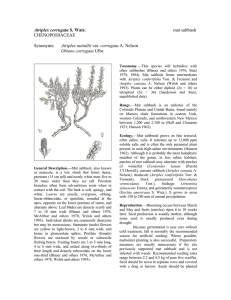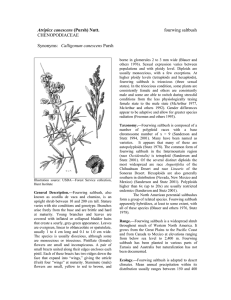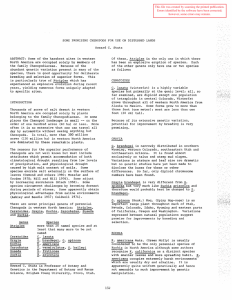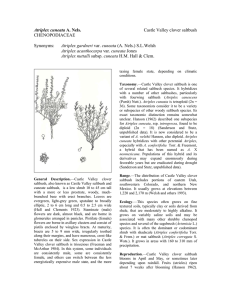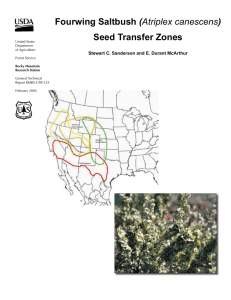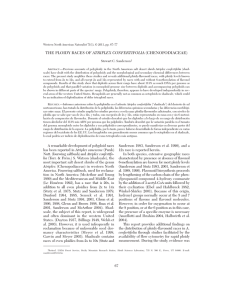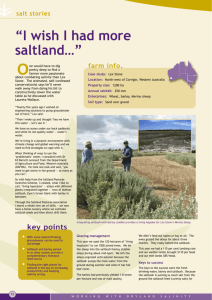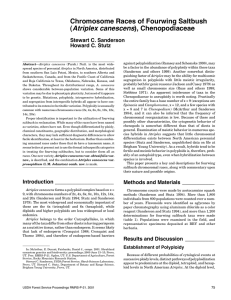WOODYCHENOPODSUSEFULFOR RANGELAND RECLAMATION IN WESTERN NORTH AMERICA Stewart C. Sanderson
advertisement
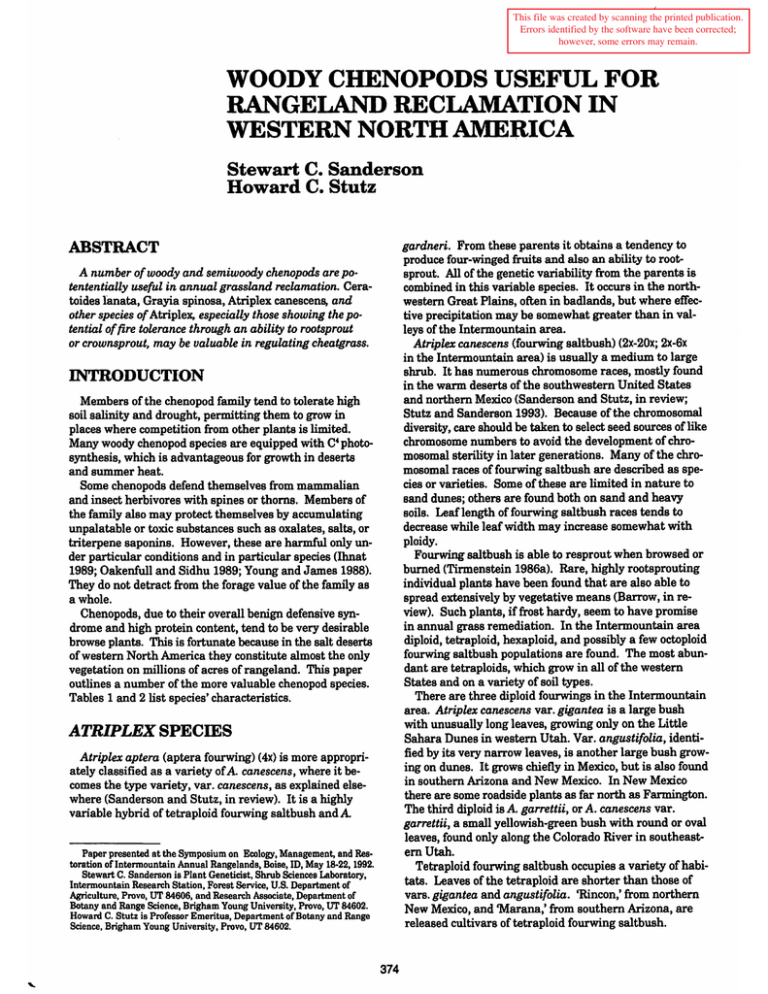
This file was created by scanning the printed publication. Errors identified by the software have been corrected; however, some errors may remain. WOODYCHENOPODSUSEFULFOR RANGELAND RECLAMATION IN WESTERN NORTH AMERICA Stewart C. Sanderson Howard C. Stutz gardneri. From these parents it obtains a tendency to produce four-winged fruits and also an ability to rootsprout. All of the genetic variability from the parents is combined in this variable species. It occurs in the northwestern Great Plains, often in badlands, but where effective precipitation may be somewhat greater than in valleys of the Intermountain area. Atriplex canescens (fourwing saltbush) (2x-20x; 2x-6x in the Intermountain area) is usually a medium to large shrub. It has numerous chromosome races, mostly found in the warm deserts of the southwestern United States and northern Mexico (Sanderson and Stutz, in review; Stutz and Sanderson 1993). Because of the chromosomal diversity, care should be taken to select seed sources of like chromosome numbers to avoid the development of chromosomal sterility in later generations. Many of the chromosomal races of fourwing saltbush are described as species or varieties. Some of these are limited in nature to sand dunes; others are found both on sand and heavy soils. Leaf length of fourwing saltbush races tends to decrease while leaf width may increase somewhat with ploidy. Fourwing saltbush is able to resprout when browsed or burned (Tirmenstein 1986a). Rare, highly rootsprouting individual plants have been found that are also able to spread extensively by vegetative means (Barrow, in review). Such plants, if frost hardy, seem to have promise in annual grass remediation. In the Intermountain area diploid, tetraploid, hexaploid, and possibly a few octoploid fourwing saltbush populations are found. The most abundant are tetraploids, which grow in all of the western States and on a variety of soil types. There are three diploid fourwings in the Intermountain area. Atriplex canescens var. gigantea is a large bush with unusually long leaves, growing only on the Little Sahara Dunes in western Utah. Var. angustifolia, identified by its very narrow leaves, is another large bush growing on dunes. It grows chiefly in Mexico, but is also found in southern Arizona and New Mexico. In New Mexico there are some roadside plants as far north as Farmington. The third diploid is A. garrettii, or A. canescens var. garrettii, a small yellowish-green bush with round or oval leaves, found only along the Colorado River in southeastem Utah. Tetraploid fourwing saltbush occupies a variety of habitats. Leaves of the tetraploid are shorter than those of vars. gigantea and angustifolia. 'Rincon,' from northern New Mexico, and 'Marana,' from southern Arizona, are released cultivars of tetraploid fourwing saltbush. ABSTRACT A number of woody and semiwoody chenopods are potententially useful in annual grassland reclamation. Ceratoides lanata, Grayia spinosa, Atriplex canescens, and other species of Atriplex, especially those showing the potential of fire tolerance through an ability to rootsprout or crownsprout, may be valuable in regulating cheatgrass. INTRODUCTION Members of the chenopod family tend to tolerate high soil salinity and drought, permitting them to grow in places where competition from other plants is limited. Many woody chenopod species are equipped with C" photosynthesis, which is advantageous for growth in deserts and summer heat. Some chenopods defend themselves from mammalian and insect herbivores with spines or thorns. Members of the family also may protect themselves by accumulating unpalatable or toxic substances such as oxalates, salts, or triterpene saponins. However, these are harmful only under particular conditions and in particular species (Ihnat 1989; Oakenfull and Sidhu 1989; Young and James 1988). They do not detract from the forage value of the family as a whole. Chenopods, due to their overall benign defensive syndrome and high protein content, tend to be very desirable browse plants. This is fortunate because in the salt deserts of western North America they constitute almost the only vegetation on millions of acres of rangeland. This paper outlines a number of the more valuable chenopod species. Tables 1 and 2list species' characteristics. ATRIPLEX SPECIES Atriplex aptera (aptera fourwing) (4x) is more appropriately classified as a variety of A. canescens, where it becomes the type variety, var. canescens, as explained elsewhere (Sanderson and Stutz, in review). It is a highly variable hybrid of tetraploid fourwing saltbush and A Paper presented at the Symposium on Ecology, Management, and Restoration of Intermountain Annual Rangelands, Boise, ID, May 18-22, 1992. Stewart C. Sanderson is Plant Geneticist, Shrub Sciences Laboratory, Intermountain Research Station, Forest Service, U.S. Department of Agriculture, Provo, UT 84606, and Research Associate, Department of Botany and Range Science, Brigham Young University, Provo, UT 84602. Howard C. Stutz is Professor Emeritus, Department of Botany and Range Science, Brigham Young University, Provo, UT 84602. 374 Table 1-Characteristics of selected species of North American perennial Atriplex Taxon A. canescens A. confertifolia A.aptera A.gardneri A. falcata A. tridentata Hybrids with A. canescens Ploidy Forage use Soil salinity Rootsprouting Remediation potential 2x-20x 2x-10x 4x 2x,4x 2x 4x,6x palatable spiny palatable palatable palatable palatable medium medium to higher medium to higher medium to higher low to higher high crown sprouts no yes yes yes yes good usually poor moderately good moderately good good specialized sites only 4x, 6x palatable low medium yes good Populations of tetraploids contain occasional plants that are hexaploid; occasionally entire populations of hexaploids are found. As shown in Stutz and Sanderson (1979), hexaploids are quite common in Arizona, New Mexico, and Nevada. In addition there is a small hexaploid population growing at Grantsville, UT, which we called "tooelensis." It lacks saponins, has furfuraceous foliage, and flowers very late (mostly in September). The hexaploid race in western Nevada has a distinctive flavonoid pattern compared to other tetraploids or hexaploids, and because it is shorter in stature, is referred to as "nana." It seems that polyploids have an advantage in being able to grow in saltier soils (Sanderson and others 1987). "Nana" grows in transitional areas between the warm desert and cold desert. Fourwing saltbush races and their ecotypes provide a rich variety of useful genotypes that may prove helpful in revegetation. In addition to those mentioned, there are numerous others existing in the southwestern United States and Mexico that would be useful in warmer climates. Atriplex confertifolia (shadscale) (2x-10x) occurs from Oregon and California to North Dakota and Texas, and marginally into Mexico. It consists of numerous chemical and chromosomal races (Sanderson and others 1990; Stutz and Sanderson 1983). For this reason, as with A canescens, care must be taken in selecting seed sources of shadscale so that incompatible chromosome races are not interplanted. Shadscale is usually a small- to mediumsized shrub. Although spring growth is palatable and nutritious and the plants are saponin free, young branches rapidly develop into spines, reducing the accessibility of forage. Shadscale palatability is lower at other times of year (Dayton 1937). Shadscale is the Atriplex dominant most often replaced by cheatgrass because, except for occasional restablishment from seed, the species does not recover from fire. Unless cultivars with much more favorable characteristics can be developed, it seems unlikely that shadscale will be of value in recovering cheatgrassinfested sites. It will remain important on sites where annuals are not a problem. Atriplex falcata (falcate saltbush) (2x) is a low-growing subshrub that can grow on badland outcrops or on welldrained valley slopes. It is mainly found in the States of Utah, Nevada, Idaho, and Oregon. The spring leaves are linear, somewhat like those of fourwing saltbush, but these are replaced by very small, persistent leaves in the fall and winter. Falcate saltbush tends to exclude other vegetation, forming monotypic stands. Even cheatgrass may be excluded on more saline soils. Although predominantly caespitose, it sprouts readily from the crown and roots when damaged, and most populations also occasionally vegetatively reproduce by roots prouts. Because it forms small, isolated populations (suggesting that larger, more continuous populations are unstable), and has been observed to die out suddenly, disease problems may exist. Nevertheless, because of its resprouting ability, A. falcata is a species that should be useful in fireaffected areas. Falcate saltbush can be distinguished from A tridentata, which is vegetatively similar but occupies a different ecological setting, by the presence of bitter saponins in the foliage and by the distinctive falcate (curved) fruit beak (fig. 1). Atriplex gardneri (A gardneri var. gardneri) (Gardner saltbush) (2x, 4x) is a prostrate to upright, low shrub found on saline and often barren clays, frequently growing in large pure stands, mainly in Wyoming and Montana. With age, plants spread into circular patches. It differs from A falcata and A. tridentata in having roundish, oval to cuneate or obcuneate leaves. Gardner saltbush resists fire through low flammability and also through resprouting (Tirmenstein 198Gb). Often found with grasses or sagebrush, it has at least a degree of competitive ability. Atriplex gardneri is a species that merits experimentation on cheatgrass sites. a b Figure 1-Fruits of Atriplex tridentata (a, b) and A. falcata (c, d). The seed is covered by two clamshell-like bracts that have teeth along their margins or a long beak. Both species can have bumps or soft spines on the sides of the fruiting bracts, but they are more common in A. falcata. 375 c d Atriplex tridentata (trident saltbush) (mostly 6x) is a strongly rootsprouting subshrub similar in appearance to falcate saltbush. However, in contrast to that species, it is free of bitter saponins and is found in highly saline bottomlands, often with Sarcobatus vermiculatus. Because of abundant rootsprouting, it may spread into large clonal patches. The plants have narrow, linear leaves like those of falcate saltbush, but the fruits have three to seven marginal teeth rather than a long beak (fig. 1). As discussed later, trident saltbush has a tendency to form hybrids and hybrid derivative populations by crossing with fourwing saltbush. backcrossing to one of the parental species, these gametes might have given rise to either tetraploid or hexaploid hybrid derivatives. However, those in nature that clearly belong to this parental combination are, so far, all 2n = 54 (hexaploid). The numerous distinctive populations of these hybrid derivatives provide a rich source of genetic variation for use in reclamation. SHRUBBY NON-ATRIPLEX CHENOPODS Allenrolfea occidentalis (iodine bush) is a succulent shrub or subshrub with jointed green stems that grows at the margins of salt marshes and on salt flats, from Oregon and California to Texas and Mexico (Welsh and others 1987). Great Basin plants are small shrubs to subshrubs, but plants from other places may be larger. Those in California's Central Valley are strong, woody shrubs several feet high, and perhaps deserve to be classified as a separate species or variety. The consumption of its foliage by herbivores is limited by a high salt content. Because it is very halophilic and dependent on high water tables, it does not grow to any extent in cheatgrass habitats, and is therefore not likely to be useful in remediation of such areas. Ceratoides lanata (winterfat) is a densely pubescent shrub or subshrub occurring from southern Canada to California and Texas. Winterfat often forms huge, pure stands excluding other shrubs. It also grows withAtriplex or Artemisia. Although its hairiness would be a deterrent to insect attack (Smith 1989), the plant is eaten readily by mammals and is an important source of browse. There are two widespread forms of winterfat, a short-statured one more northern in distribution, and a large one (for example, Hatch winterfat) mostly found in warm deserts. Winterfat resprouts after fire (Holifield 1987a); however, a solid stand of winterfat often partly excludes cheatgrass, reducing the frequency of fire. It is readily established from seed (McArthur and Monsen, in review). Grayia brandegii (spineless hopsage) is palatable but uncommon (Holifield 1987b), found only on steep, welldrained outcrops of highly saline and seleniferous shales on the Colorado Plateau, mostly in eastern Utah but including portions of neighboring Wyoming, Colorado, New Mexico, and Arizona. These shales are often brightly colored red, or white and purple, such as the Morrison Shale formation. Usually, little cheatgrass is present, and it is expected that the competitive ability of spineless hopsage is low except on unusually saline soils. Grayia spinosa (spiny hopsage), which occurs from Washington to Montana and California to New Mexico, is common in the upper elevations of the Mojave Desert. It grows in valleys and hills of the Great Basin well into the pinyon-juniper community, on soils of low to moderate salinity. It is very palatable when bearing leaves but its usefulness as a range plant is limited; it sheds leaves and fruits in early summer (McArthur and Monsen, in review). Spiny hopsage resprouts readily after light burning (Holifield 1987c), but can sometimes be killed by tire. Kochia americana (gray molly) occurs from Oregon to Montana and from California to New Mexico. It is a small subshrub that forms stands of rather widely spaced plants ATRIPLEX HYBRIDS Atriplex canescens x A. gardneri: Individual first generation plants having this evident parentage are common where fourwing saltbush plants have established themselves along roadsides near Gardner saltbush populations. Hybrids are also found occasionally at considerable distances from plants of fourwing saltbush, apparently due to wind transport of the pollen. The hybrids are easy to find because they tower above Gardner saltbush plants. Although Gardner saltbush has both diploid and tetraploid populations, most of the hybridization occurs at the tetraploid level. Because of genetic segregation among the progeny of hybrids, hybrids can form a large source of variation for natural or artificial selection. There are also vast areas where populations of both parents have come together in the past and formed populations of aptera saltbush, a new and still developing species, as already mentioned. Atriplex cansecens xA falcata: These hybrids have been formed synthetically in the garden, and a number of distinct native hybrid populations in the Great Basin are suggested to have this parentage (Hanson 1962). Evidence has been presented (Stutz and others 1979), however, that some of the populations in question are derived from the hybridization of A canescens and A tridentata, as discussed later. Even if there are no hybrids in nature having A falcata as a parent, interesting selections could be produced using synthetic hybrids as a source of variation. Atriplex canescens x A tridentata: An odd-ploid seedling with a chromosome count of 2n = 45 (pentaploid) (Pope 1976) was grown from seed collected from a lone female A. canescens plant near Grantsville, UT, pollinated by distant male bushes. Other seedlings from the same plant had counts of 2n = 36 (tetraploid), which was inferred to be the chromosome number of the A. canescens plant. A search of the site revealed numerous plants of A tridentata close at hand; these proved to have a higher chromosome number of 2n =54, which could have produced the pentaploid seed by hybridization. Several adult hybrids were found. Many other such areas of hybridization were eventually encountered-huge populations that appeared to have resulted from hybridization of these parents (Stutz and others 1979). Although odd-ploidy is unstable in sexually reproducing organisms because most of the gametes are unbalanced, it was found in this case to rapidly resolve itself, apparently because euploid (balanced) gametes, which are occasionally produced, have a viability advantage. Through 376 Table 2-Characteristics of shrubby North American chenopod species Taxon Allenrolfea occidentalis Ceratiodes /anata Grayia brandegii Grayia spinosa Kochia americana Sarcobatus baileyi Sarcobatus vermiculatus Suaedato"eyana Zuckia arizonica Ploidy 2x 2x 2x,4x 4x 2x 12x 4x, ax 2x 2x Forage use low palatable palatable early decid. palatable spiny low low palatable Habitats Halophyllcity salt flats, marshes valleys, hills saline shale outcrops valleys, hills saline barrens & hills arid slopes saline bottomlands saline bottoms & flats saline clay, shale in barren, highly saline areas such as valley bottoms. Because it spreads vegetatively by occasional root- sprouting, it should withstand fire well. However, its habitat suggests that most ecotypes of gray molly would have relatively little competitive ability against communities of introduced annuals. Sarcobatus baileyi (Bailey greasewood) is a densely spiny, deciduous shrub, up to about one-half meter in height, that forms solid stands on arid hillsides in westem Nevada and adjacent California. It often grows with Atriplex confertifolia. Bailey greasewood's leaves are fleshy and narrow, like those of Sarcobatus vermiculatus. It can presumably resprout after fire like that species. It occurs slightly below and to the south of major cheatgrass zones, but because it is not dependent on water tables like its congener, Bailey greasewood may be worth a trial with cheatgrass. Sarcobatus vermiculatus (black greasewood) is a larger deciduous shrub with much variability, found from Sonora to Alberta and California to Texas. It has tetraploid and octaploid races, but plants in the Intermountain region are all octaploid. It grows mainly in saline bottomlands having high water tables. There are some populations occurring in soils where cheatgrass is able to grow abundantly, and in such cases greasewood resprouts vigorously from its roots after the grass has been burned (Tirmenstein 1987). Suaeda torreyana (inkbush) occurs from California and Wyoming to Mexico. It is a plant of more saline soils, often growing in the presence of high water tables. The leaves are narrow and fleshy, similar in form to those of Sarcobatus. They tum inky black upon dying in the fall. Inkbush seldom grows where annual grasses are abundant. Zuckia arizonica (zuckia) is an uncommon plant of barren clay or shale in the Colorado Plateau, in eastern Utah and northern Arizona. It hybridizes with Grayia brandegii and is therefore related to it, though the fruits are dissimilar. Like that species, it is not found in dense stands of grass. very strong weak to moderate strong weak strong moderate moderate to strong strong strong Apparent cheatgrass remediation potential none very useful low probably good low moderate? should be tested good for specialized sites low low Dayton, W. A. 1937. Range plant handbook. Washington, DC: U.S. Department of Agriculture, Forest Service. Reprinted in 1988 by Dover Publications Inc., Mineola, NY.816p. Hanson, Craig A. 1962. New species of perennial Atriplex from the western United States. Studies in Systematic Botany. 1: 1-4. Holifield, J. L. 1987a. Ceratoides lanata. In: Fischer, William C., comp. The Fire Effects Information System [Data Base]. Missoula, MT: U.S. Department of Agriculture, Forest Service, Intermountain Research Station, Intermountain Fire Sciences Laboratory. Magnetic tape reels; 9 track; 1600 bpi, ASCII with common LISP present. Holifield, J. L. 1987b. Grayia brandegii. In: Fischer, William C., comp. The Fire Effects Information System [Data Base]. Missoula, MT: U.S. Department of Agriculture, Forest Service, Intermountain Research Station, Intermountain Fire Sciences Laboratory. Magnetic tape reels; 9 track; 1600 bpi, ASCII with common LISP present. Holifield, J. L. 1987c. Grayia spinosa. In: Fischer, William C., comp. The Fire Effects Information System [Data Base]. Missoula, MT: U.S. Department of Agriculture, Forest Service, Intermountain Research Station, Intermountain Fire Sciences Laboratory. Magnetic tape reels; 9 track; 1600 bpi, ASCII with common LISP present. Ihnat, Milan. 1989. Plants and agricultural materials. In: Ihnat, Milan, ed. Occurrence and distribution of selenium. Boca Raton, FL: CRC Press Inc.: 33-105. McArthur, E. Durant; Monsen, Steven B. [In review]. Chenopod shrubs. Chapter IV. In: Monsen, Steven B.; Stevens, Richard, tech. coords. Rehabilitation of westem range and wildlands. Gen. Tech. Rep. Ogden, UT: U.S. Department of Agriculture, Forest Service, Intermountain Research Station. Oakenfull, David; Sidhu, Gurcharn S. 1989. Saponins. Chapter 4. In: Cheeke, Peter R., ed. Toxicants of plant origin. Vol. II. Boca Raton, FL: CRC Press Inc.: 97-141. Pope, C. Lorenzo. 1976. A phylogenetic study of the suffrutescent shrubs in the genus Atriplex. Provo, UT: Brigham Young University. Dissertation REFERENCES Barrow, Jerry R. [In review]. Natural asexual reproduction inAtriplex canescens. 377 Sanderson, Stewart C.; McArthur, E. Durant; Stutz, Howard C. 1987. A relationship between ploidy and habitat in western shrub species. In: Wallace, Arthur; McArthur, E. Durant; Haferkamp, Marshall R., comps. Proceedings-symposium on shrub ecophysiology and biotechnology. Gen. Tech. Rep. INT-256. Ogden, UT: U.S. Department of Agriculture, Forest Service, Intermountain Research Station: 23-30. Sanderson, Stewart C.; Stutz, Howard C. [In review]. High chromosome numbers in Mojavean and Sonoran Botany and Range Science, Brigham Young University, Provo, UT 84602. Tirmenstein, Debra A. 1986a. Atriplex canescens. In: Fischer, William C., comp. The Fire Effects Information System [Data Base]. Missoula, MT: U.S. Department of Agriculture, Forest Service, Intermountain Research Station, Intermountain Fire Sciences Laboratory. Magnetic tape reels; 9 track; 1600 bpi, ASCII with common LISP present. Tirmenstein, Debra A. 1986b. Atriplex gardneri. In: Fischer, William C., comp. The Fire Effects Information System [Data Base]. Missoula, MT: U.S. Department of Agriculture, Forest Service, Intermountain Research Station, Intermountain Fire Sciences Laboratory. Magnetic tape reels; 9 track; 1600 bpi, ASCII with common LISP present. Tirmenstein, Debra A. 1987. Sarcobatus vermiculatus. In: Fischer, William C., comp. The Fire Effects Information System [Data Base]. Missoula, MT: U.S. Department of Agriculture, Forest Service, Intermountain Research Station, Intermountain Fire Sciences Laboratory. Magnetic tape reels; 9 track; 1600 bpi, ASCII with common LISP present. Welsh, Stanley L.; Atwood, N. Duane; Goodrich, Sherel; Higgins, Larry C. 1987. A Utah flora. Great Basin Naturalist Memoirs No. 9. 894 p. Young, James A.; James, Lynn F. 1988. Oxalate poisoning. In: James, Lynn F.; Ralphs, Michael H.; Nielsen, Darwin B., eds. The ecology and economic impact of poisonous plants on livestock production. Boulder, CO: Westview Press: 261-274. Atriplex canescens. Sanderson, Stewart C.; Stutz, Howard C.; McArth~, E. Durant. 1990. Geographic differentiation in Atriplex confertifolia. American Journal of Botany. 77: 490-498. Smith, C. Michael. 1989. Plant resistance to insects: a fundamental approach. New York: John Wiley. 286 p. Stutz, Howard C.; Pope, C. Lorenzo; Sanderson, Stewart C. 1979. Evolutionary studies of Atriplex: adaptive products from the natural hybrid 6n A tridentata x4n A canescens. American Journal of Botany. 66: 1181-1193. Stutz, Howard C.; Sanderson, Stewart C. 1979. The role of polyploidy in the evolution of Atriplex canescens. In: Goodin, J. R.; Northington, David K., eds. Arid land plant resources. Lubbock, TX: International Center for Arid and Semi-arid Land Studies, Texas Tech University: 615-621. Stutz, Howard C.; Sanderson, Stewart C. 1983. Evolutionary studies of Atriplex: chromosome races of Atriplex confertifolia (shadscale). American Journal of Botany. 70: 1536-1547. Stutz, Howard C.; Sanderson, Stewart C. 1993. Unpublished chromosome data on file at the Department of 378
